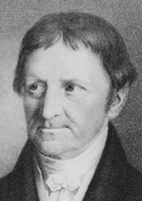
Wilhelm Daniel Joseph Koch
Encyclopedia

Kusel
Kusel is a municipality in Rhineland-Palatinate, Germany, capital of the district of Kusel. It is situated approx. 30 km north-west of Kaiserslautern....
, a town in the Rhineland-Palatinate
Rhineland-Palatinate
Rhineland-Palatinate is one of the 16 states of the Federal Republic of Germany. It has an area of and about four million inhabitants. The capital is Mainz. English speakers also commonly refer to the state by its German name, Rheinland-Pfalz ....
.
Koch studied medicine at the Universities of Jena and Marburg, and afterwards was a Stadtphysicus (state physician) in Trarbach and Kaiserslautern
Kaiserslautern
Kaiserslautern is a city in southwest Germany, located in the Bundesland of Rhineland-Palatinate at the edge of the Palatinate forest . The historic centre dates to the 9th century. It is from Paris, from Frankfurt am Main, and from Luxembourg.Kaiserslautern is home to 99,469 people...
(1798). In 1824 he became a professor of medicine and botany
Botany
Botany, plant science, or plant biology is a branch of biology that involves the scientific study of plant life. Traditionally, botany also included the study of fungi, algae and viruses...
at the University of Erlangen, where he remained for the rest of his life. At Erlangen
Erlangen
Erlangen is a Middle Franconian city in Bavaria, Germany. It is located at the confluence of the river Regnitz and its large tributary, the Untere Schwabach.Erlangen has more than 100,000 inhabitants....
he was also director of its Botanical Gardens. In 1833, he was elected a foreign member of the Royal Swedish Academy of Sciences
Royal Swedish Academy of Sciences
The Royal Swedish Academy of Sciences or Kungliga Vetenskapsakademien is one of the Royal Academies of Sweden. The Academy is an independent, non-governmental scientific organization which acts to promote the sciences, primarily the natural sciences and mathematics.The Academy was founded on 2...
.
He best known written work was a treatise on German and Swiss flora titled Synopsis florae germanicae et helveticae (1835-37). Another noteworthy publication of his was Catalogus plantarum florae palatinae (Catalogue of Palatinate Flora) (1814).
The plant genus
Genus
In biology, a genus is a low-level taxonomic rank used in the biological classification of living and fossil organisms, which is an example of definition by genus and differentia...
Kochia
Kochia
Kochia is a synonym of the genus Bassia, that belongs to the subfamily Camphorosmoideae of family Amaranthaceae.Two american species traditionally included in Kochia are now in genus Neokochia: Neokochia americana and Neokochia californica....
from the subfamily Chenopodioideae
Chenopodioideae
The Chenopodioideae is a subfamily of the flowering plant family Amaranthaceae, formerly classified in family Chenopodiaceae.Food species include several Chenopodium species , Orache , and Spinach .-Genera:The subfamily includes about 25 genera.* Tribus Atripliceae C. A...
is named after him.

